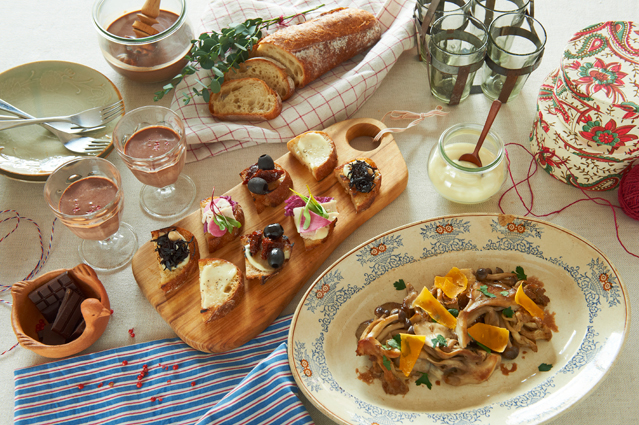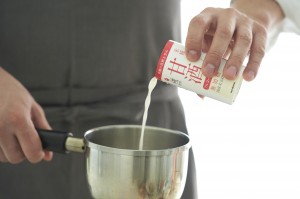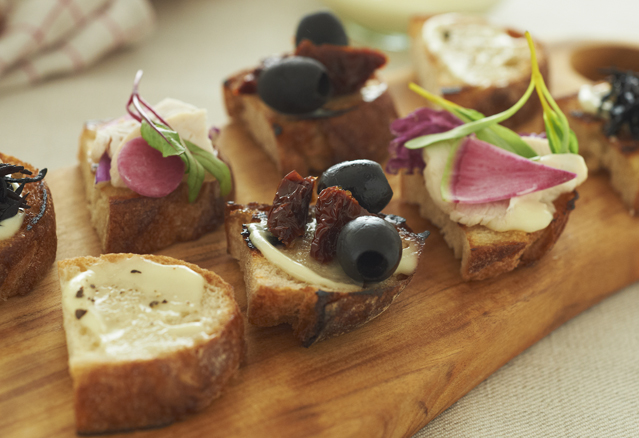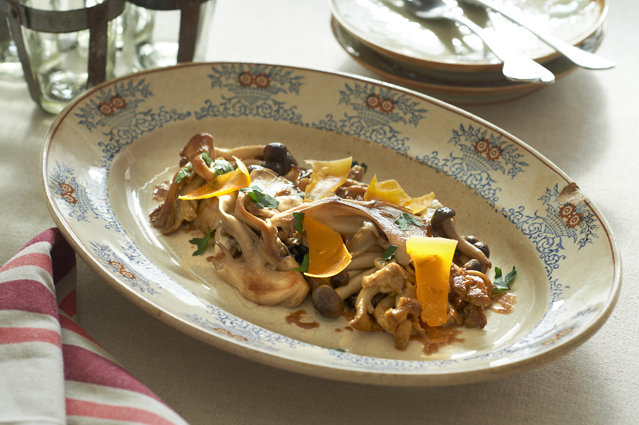Amazake Recipes for a Festive Winter Party
Dec 16,2016
Amazake Recipes for a Festive Winter Party
Dec 16,2016

Winter is a season when we get together with friends for Christmas and year-end and New Year parties. I imagine many of you enjoy entertaining at home. In this edition, French Basque cuisine chef Mutō Yasuyuki-san teaches us dishes featuring amazake that are perfect for the party season.
Amazake is strongly associated with Japan but, Mutō-san believes, it can also be used in many ways outside of Japanese cuisine.
“Japanese fermented foods have become ‘it’ ingredients with European chefs, including French chefs. Some use miso and soy sauce. And amazake’s gentle sweetness and umami are also great in western cuisines.”
Winter is such a busy season and tiredness just seems to build up. At your next fun get-together, why not serve up these simple, delicious and elegant dishes using amazake, which has long been said to help create a beautiful complexion and aid in fatigue recovery.

This time we use Marukome’s Plus Koji Koji-Amazake LL. “Its features are its mild sweetness and its smoothness. I think it’s an easy amazake to use in cooking. It has sweetness and umami, so I think it can be used in all kinds of cooking, as you would with sugar or mirin,” says Muto-san.
The first recipe, Chocolat Chaud, is French for hot chocolate. It’s a classic winter drink in cafes and tea salons across France.
“The gentle sweetness of Amazake, which is sugar-free, is a really good match for chocolate. These days, it’s easy to buy higher cacao chocolate at convenience stores and supermarkets, so I think you will find this recipe easy to make. If you use pink pepper as a garnish and flavor accent, it becomes very festive.”
The Garlic Purée Canapés are an elegant dish perfect for parties.
“Garlic is known to be a good match for fermented foods. In particular, the sweetness of amazake is the perfect pair for the mellow taste of garlic. Here, I spread garlic purée on crusty bread and top it with a variety of colorful ingredients and plate it for entertaining, but it would be equally delicious with just a grind of black pepper. Once you learn how to make the garlic purée, you can use it not just in canapés, but in all sorts of ways, including as a sauce in sandwiches, as a dip for vegetables, and as a sauce for meat. It can even be transformed into bagna càuda sauce with the addition of some anchovies.”
The Amazake-Ginger Sauteed Exotic Mushrooms features the fresh combination of amazake and sourness.
“In Japan, there are many condiments that give a salty finish, including miso and soy sauce, but French cuisine can largely express saltiness with salt alone. On the other hand, it has a large canon of sour-umami treats created by reducing vinegar, among other means. This kind of sourness is a great foil for amazake. With the Amazake-Ginger Sauteed Exotic Mushrooms, we combine this with sweetness and the umami flavor of kōji (malted rice), creating a fragrant dish.”


[ Ingredients (Makes 2 servings)]
1 carton Amazake(125ml)
50 g 70% cacao dark chocolate, broken into pieces (See notes)
30 ml fresh cream
180 ml milk
Pink pepper corns to garnish
[Method]
1.In a small pot, gently heat the amazake, cream and milk.
2.Add the dark chocolate and stir until melted then remove from the heat.
3.Pour into glasses and garnish with the pink peppercorns.
Notes: Bar chocolate is recommended as it melts easier.
Adding cocoa powder will give a richer, thicker, more fragrant finish.

[Ingredients (Makes 2 servings)]
For the garlic purée
1 head garlic (approx. 50 g)
1/2 carton Amazake (62 ml)
150 ml milk
40 ml vegetable oil
20ml extra virgin olive oil
Pinch of salt
For the canapés
1 baguette or other crusty bread
Suggested toppings
Sun dried tomatoes + olives
Simmered hijiki
Salad vegetables (baby leaves+ round red core radish) + steamed chicken
Also: Ham, roast pork, honey, or anything else you fancy
[Method]
1.Peel the garlic and remove any shoots growing in the center of each clove.
2.Place the garlic in a pot of cold water and bring to the boil. Drain and repeat twice more to remove the garlic’s pungency.
3.Place the garlic, amazake and milk in a pot and simmer gently for around 20 minutes until the garlic becomes soft.
4.Mash the garlic (See notes) .
5.Add the vegetable and olive oils (See notes), mix well and season with salt.
6.Slice the baguette and spread with the garlic purée
7.Garnish with your favorite toppings.
Notes: The purée will be delicious if you mash the garlic roughly, but will be smoother if you push it through a fine strainer.
For best flavor, I recommend using the vegetable and olive oils in the suggested amounts, but the puree can be made with vegetable oil only, and drizzled with a little extra virgin oil to finish. Using only extra virgin olive oil may overpower the garlic, so I don’t recommend this. Regular olive oil can be used in place of the vegetable oil.

[Ingredients (Makes 2 servings)]
1 pack each maitake and shimeji mushrooms
2 tbsp Plus Koji Koji-Amazake LL Ginger
1 tsp balsamic vinegar
Italian parsley to garnish
Mimolette cheese to garnish
[Method]
1.Clean the mushrooms and slice off their bases. Break or tear into bite-size pieces.
2.In a frying pan, heat a little oil and stir-fry the mushrooms.
3.Once the mushrooms are cooked, add the amazake (see note) and balsamic vinegar and heat only long enough to burn off the acidity and flavor the mushrooms.
4.Transfer to a serving dish and garnish with Italian parsley and thin slices of mimolette cheese.
Note: I’ve used Plus Koji Koji-Amazake LL Ginger , but the recipe is also delicious made with plain Amazake.

After years learning his craft in restaurants in and outside of Japan, including a famous restaurant in Tokyo and an organic/seasonal restaurant, Mutō-san became a chef at a French restaurant in Hiroo, Tokyo. He went to France in 2009, returning to Japan in 2011 after stints working in Paris, Burgundy and French Basque Country. After working as Sous Chef de Cuisine at a venerable French restaurant in Daikanyama, he became a Japan Sommelier Association qualified Sommelier, further broadening his activities.